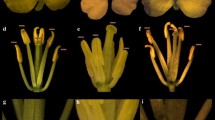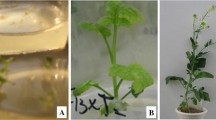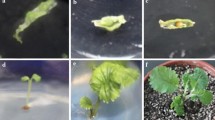Abstract
Alloplasmic Brassica juncea was synthesized by repeatedly backcrossing amphidiploid of Erucastrum gallicum × B. juncea with pollen of B. juncea. The E. gallicum cytoplasm was also transferred to B. napus and B. carinata through alloplasmic (E. gallicum) B. juncea. RFLP analyses of organelle DNA confirmed the presence of E. gallicum cytoplasm in all the alloplasmics. The cytoplasm of E. gallicum, though alien, did not induce stable cytoplasmic male sterility in any of the oilseed brassicas. Many useful variants such as early flowering and dwarf phenotypes were isolated in the alloplasmics of B. napus and B. carinata. These morphotypes provide useful genetic variability for the improvement of crop brassicas.
Similar content being viewed by others
References
Alt, J., J. Morris, P. Westhoff & R.G. Hermann, 1984. Nucleotide sequence of the clustered genes for the 44 kd chlorophyll a protein and 32 kd like protein of the photosystem II reaction centre in spinach plastid chromosome. Curr Genet 8: 597-606.
Banga, S.S., 1993. Heterosis and its utilization. In: K.S. Labana, S.S. Banga & S.K. Banga (Eds), Breeding Oilseed Brassicas, pp. 21-43, Springer-Verlag, Berlin.
Banga, S. S., K.S. Labana & B.W. Medhi, 1984. Alternariaincidence in some alloplasmic lines of Indian mustard [Brassica juncea(L.) Coss.]. Theor Appl Genet. 67: 195-196.
Batra, V., 1992. Hybridization between cultivated brassicas and their two wild relatives (Diplotaxisand Erucastrum), Ph.D. Thesis, University of Delhi.
Batra, V., Shivanna, K.R. & S. Prakash, 1989. Hybrids of wild species Erucastrum gallicumand crop brassicas, pp. 443-446, Proc 6th Internatl Congr of SABRAO, Japan.
Beversdorf, W.D., Weiss-Lerman, J., Erickson, L.R. & M.V. Souza, 1980. Transfer of cytoplasmically inherited triazine resistance from brid's rape to cultivated oilseed rape (Brassica campestrisand Brassica napus). Can J Genet Cytol 22: 167-172.
Bhargava, S.C., Tomar, D.P.S. & S.K. Sinha, 1983. Physiological basis of a plant type in oleiferous Brassica, pp. 472-476, Proc 6th Internatl Rapeseed Congr, Paris.
Chopra, V.L., Kirti, P.B. & S. Prakash, 1996. Accessing and exploiting genes of breeding value of distant relatives of crop brassicas. Genetica 97: 305-312.
Dellaporta, S.L., Wood, J. & J.B. Hicks, 1984. Maize DNA miniprep. In: Molecular Biology of Plants: A Laboratory Course Manual, pp. 36-37, Cold Spring Harbour Laboratory, Cold Spring Harbour, New York.
Namai, H., 1987. Inducing cytogenetical alterations by means of interspecific and intergeneric hybridization in Brassicacrops. In: Gamma Field Symposia No. 26: 41-87.
Narasimhulu, S.B., Chopra, V.L. & S. Prakash, 1989. Cytoplasmic influences for shoot regeneration in Brassica carinataA. Br. Euphytica 40: 241-243.
Pearson, O.H., 1972. Cytoplasmically inherited male sterility characters and flavour components from the species cross Brassica nigra(L.) Koch × B. oleraceaL. J Am Soc Hort Sci 97: 397-402.
Pradhan, A.K., Prakash, S., Mukhopadhyay, A. & D. Pental, 1992. Phylogeny of Brassica and allied general based on variation in chloroplast and mitochondrial DNA pattern: molecular and taxonomic classifications are incongruous. Theor Appl Genet. 85: 331-340.
Prakash, S. & V.L. Chopra, 1991. Origin and evolution. In: Oilseed Brassicas in Indian Agriculture, pp. 60-85, Vikas Publishing House, New Delhi.
Rao, G.U., Batra-Sarup, V., Prakash, S. & K.R. Shivanna, 1994. Development of a new cytoplasmic male sterile system in Brassica junceathrough wide hybridization. Plant Breed 112: 171-174.
Rao, G.U. & K.R. Shivanna, 1996. Development of new alloplasmic CMS Brassica napusin the cytoplasmic background of Diplotaxis siifolia. Cruciferae Newslett 18: 68-89.
Rao, G.U. & K.R. Shivanna, 1997. Alloplasmics of B. junceaas bridge-species for development of alloplasmics of other crop brassicas. Cruciferae Newslett 19: 29-30.
Roy, N.N., 1984. Interspecific transfer in Brassica juncea-type high blackleg resistance to Brassica napus. Euphytica 33: 295-303.
Shivanna, K.R., 1996. Incompatibility and wide hybridization. In: V.L. Chopra & S. Prakash (Eds), Oilseed and Vegetable Brassicas: Indian Perspective, pp. 77-102, Oxford & IBH Publishing Co., New Delhi.
Thurling, N., 1993. Physiological constraints and their genetic manipulation. In: K.S. Labana, S.S. Banga & S.K. Banga (Eds), Breeding Oilseed Brassicas, pp. 44-66, Springer-Verlag.
Warwick, S.I. & I. Black, 1993. Guide to the Wild Germplasm of Brassica and Allied Crops. III. Interspecific and intergeneric hybridization in the tribe brassiceae (Cruciferae). Agriculture Canada Research Branch Technical Bulletin 16E.
Zaman, M.W., 1989. Introgression in Brassica napusfor adaptation to the growing conditions in Bangladesh. Theor Appl Genet 77: 721-728.
Author information
Authors and Affiliations
Rights and permissions
About this article
Cite this article
Rao, G.U., Pradhan, A.K. & Shivanna, K.R. Isolation of useful variants in alloplasmic crop brassicas in the cytoplasmic background of Erucastrum gallicum. Euphytica 103, 301–306 (1998). https://doi.org/10.1023/A:1018374619110
Issue Date:
DOI: https://doi.org/10.1023/A:1018374619110




